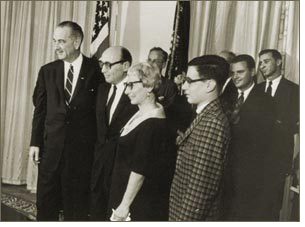

President Johnson's first two appointments to the SEC -- former Oklahoma Securities Commissioner Hugh Owens and former Idaho Republican Congressman Hamer Budge -- gave little indication that Johnson's appointee to succeed Cary would become one of the most important Chairmen in the SEC's history.(13)
Thirty years after its creation, the SEC faced a kind of mid-life crisis. Since 1941, the SEC had performed its regulatory functions in a fairly conservative manner. While the Cary years saw increased funding and investigation, the SEC remained handicapped by the "lack of a clear economic theory" for market regulation.(14)
For years, the SEC had used the principles of fiduciary duty and disclosure to regulate the markets and market practices, but it was becoming increasingly apparent that those theories were no longer always sufficient to justify the kinds of regulation that the SEC sought as the market system grew more sophisticated. The appointment of Manuel Cohen as SEC Chairman -- he would serve from August 20, 1964 until February 22, 1969 -- led to initiatives that would begin to respond to that intellectual demand.
 |
Chairman Cohen and the SEC faced imposing regulatory challenges in the securities industry in the 1960s. Trading volume had reached new heights, with total annual dollar volume of stocks traded on the NYSE increasing nearly fourfold in the "go-go years" between 1960 and 1968.
The sheer volume of activity created enormous problems for both the industry and the SEC to maintain minimum levels of review and supervision. In addition, the securities industry experienced a rapid institutionalization with mutual funds, commercial bank trust departments, insurance and pension funds, and other institutional investors that had engaged in limited involvement in the markets before then.(15)
Acknowledging that the SEC had limitations, Cohen sought Congressional support and adopted a cooperative approach with the exchanges. In a July 1964 speech to the Practicing Law Institute, he expressed self-criticism of the agency's work, announcing that the SEC had embarked upon "a continuing effort to revise, update, and improve our operations wherever possible" and to "develop more informal working procedures with registrants and their representatives."(16)
Cohen's 22 years of previous SEC experience as a staff attorney and Commissioner prepared him well for the task. He knew the law, the lore, and, just as significantly, the lay of the political landscape in Washington, DC. During his tenure, the SEC would rebuild its capabilities, reexamine its function, address concerns about excessive speculation in the market, and begin to implement an economic theory of competition and regulation that garnered substantial political support on Capitol Hill.
(13) "S.E.C. Post for Budge Approved by Senate," New York Times, June 27, 1964, 28.
(14) Seligman, 350.
(15) Ibid., 351.
(16) "S.E.C. Plans to Keep Up With Markets," New York Times, July 21, 1964, 45.